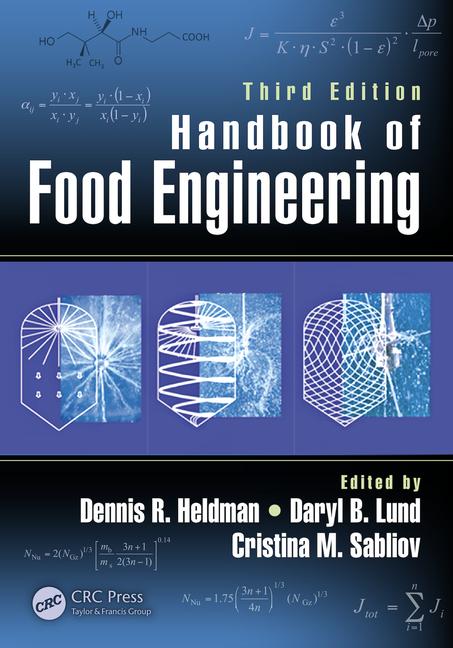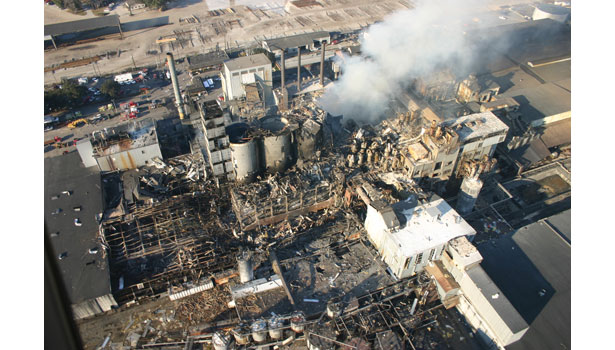Tech Update: Preventing dust explosions

On February 7, 2008, a huge explosion and fire at the Imperial Sugar refinery northwest of Savannah, GA killed 14 workers and injured 38 others, including 14 with serious and life-threatening burns. The explosion was fueled by massive accumulations of combustible sugar dust throughout the packaging building. Source: US Chemical Safety Board.

This 20-liter test sphere is used at CV Technologyâs lab to determine Kst and Pmax values of potentially explosible dusts. Source: CV Technology, Inc.


While understanding the physics of dust explosions can require college math, using the old eyeballs and some simple cleaning tools can go a long way in preventing a catastrophe.
Accidents are preventable, and in most cases, preventing them doesn’t require rocket science, but some good, old common sense, watchful eyes, proper housekeeping, appropriate technology, adequate training and the desire to have an accident-free workplace. While technology can play a big role in making plants safer, only humans can make safety the number-one priority on the job.
Although big accidents that claim many lives and injure dozens of people get media attention, simpler, preventable accidents kill and injure people in the food and beverage industry on a daily basis. For a sampling of these smaller, yet deadly accidents, see page 89.
In 2009, OSHA calculated the number of combustible dust inspections it conducted by industry type. The food industry represented 15 percent of OSHA’s total number of inspections—second only to wood products, which accounted for 25 percent. According to OSHA statistics from 1980 to 2008, combustible dust incidents among all food industry sectors totaled 74, more than twice the number of any other industry.
NFPA 654 (2006) defines combustible dust as a particulate solid that presents a fire hazard or deflagration when suspended in air (or other oxidant) at various concentrations, independent of size or shape. Which food processing facilities significantly increase their potential for combustible dust fires and/or explosions when they fail to assess the risks of processing and/or handling combustible particulate solids? Kevin N. Jeffries, senior EHS manager/frozen foods, Kellogg Company answers, “All facilities that fail to adequately assess the risks of processing and handling combustible particulate solids and implement control measures to address identified risks are likely to have an explosion or fire at some point in the life of the process.”
A measure of the explosivity (or maximum rate of pressure rise) of any dust is known as the Kst value. Unfortunately for the food industry, most dusts are organic and, therefore, explosive—some more than others, according to Rob O’Connor, Mac Process vice president, filtration. Kst is influenced by several factors, including particle size and moisture level.
Combustible materials with a particle size of 420 µm (microns) or smaller can rapidly react when exposed to oxygen and a source of ignition, causing an explosion or wave of explosions, e.g., a deflagration. A deflagration is defined as a rapid high-energy release combustion event that propagates through a gas or across the surface of an explosive material at subsonic speeds, driven by the transfer of heat.
Several tests can be run to determine the explosivity of dust in a plant, but only a handful of labs in the US have the equipment to conduct them. “The principal test we rely on is defined by ASTM protocol E1226,” says Bill Stevenson, vice president of engineering at CV Technology, Inc., a dust testing facility. The test provides both Kst and Pmax values, with Pmax being the maximum pressure developed by the particular dust under test. A “0” result indicates no explosivity; any positive results indicate some degree of explosivity, explains Stevenson.
Some process designers/engineers may look at an ingredient’s material safety data sheet (MSDS) to decide if it is potentially explosive. But it’s important to keep in mind the MSDS typically describes the material in the form that is shipped. If a processor mills or grinds the ingredient, its dust could be explosive even though the material itself is not, according to Chris Romano, Pepperl+Fuchs product portfolio manager/purge and pressurization.
OSHA categorizes dust explosion classes by the following Kst ranges: Class 0 (St 0), with Kst = 0, no explosion; Class St 1, with Kst between 0 and 200, weak explosion; Class St 2, with Kst between 200 and 300, strong explosion; and Class St3 with Kst greater than 300, a very strong explosion. Typical Kst values for food products can be found in NFPA 61, according to Gary Q. Johnson, Workplace Solutions LLC principal. For example, corn meal has a Kst of 47; cornstarch, 163; malt, 170; wheat flour, 70; soybean dust, 125; and confectioner’s sugar, 154.
Kst numbers provide a relative estimate for what can be expected in an explosion, but may instill a false sense of security. For example, corn meal (47) is less explosive than cornstarch (163), so it’s OK to be less careful with corn meal spills, right? Wrong! “I would take no comfort if I only have a Kst of 50 vs. 250,” says Johnson. “All that means is that if I have five times as much of the Kst 50 dust floating around, I have just as much risk as I do with the [dust rated at] 250.”
Kst is not the only number to consider in preventing a dust explosion. “The more important number to watch is MIE (minimum ignition energy, [ASTM E2019-99]),” says Nick Hayes, Volkmann Inc. president. “This measures the level of energy required to ignite a powder, e.g., from a static discharge, and whether the powder can be ignited from that spark.” Materials such as starch have a low MIE in the 3-5 mJ range, sugar is approximately 30 mJ, and wheat flour is around 50 mJ. The higher the number, the more energy is required to set off the powder, according to Hayes.
Minimum ignition temperature for a dust cloud or layer is another important factor, according to Johnson. In addition, dispersion of the combustible dust into a cloud denser than the minimum explosible concentration (MEC) value (ASTM E1515) is what determines if enough dust is present to cause an explosion. Johnson adds that explosible materials can also include flakes and fibers. Another factor to consider is confinement, which can be an entire building—like a grain silo—or a piece of process equipment such as a blender, mill or even a dust collector.
How much is too much?
There have been many rule-of-thumb methods to determine if there is too much dust in a space, such as when you can’t see a lit 25-watt bulb at a distance of 6 ft. in a confined space. Another method is portrayed in many ways: If you can’t see the color of a motor because a layer of dust is on it, there’s too much dust in the space. If you leave footprints on the floor, or if the dust measures more than the thickness of a paper clip (about 1/16 to 1/8 in.), there’s too much dust.
|
Relevant NFPA codes and standards for food processing/handling facilities:
|
Dust on the floor is probably an indicator of more serious issues. “The bigger hazard is what’s overhead,” says Johnson. “If you have dust on the floor, the building acts like a particle size classifier. The heavy stuff is on the floor; the medium particle diameters are on the walls; and near the roof, the finest dust will be present.” The smaller the particle size, the more explosive a material is.
The problem is getting people to take seriously what is out of sight. “Some companies are not cognizant of the level of danger they have in their plants,” says Walter Beattie, Insurance Services senior consulting engineer. “They may say, ‘Well it’s only a little bit of dust; I’m not worried about it;’ or ‘It’s high up on these rafters, and it’s not a problem.’” But the danger, states Beattie, is real. Dust accumulated on rafters or interstitial locations and in duct work can be set into motion by a primary blast on the floor. Once airborne, this dust can be exploded by the release of energy in the primary explosion, resulting in a chain of explosions racing through a plant.
Another way of thinking that results in denial goes like this, according to Beattie. Some people think that once they eliminate the electrical hazard in the dust area, everything will be OK. “The fact of the matter is that a dust explosion is a haphazard arrangement of different, unrelated things going wrong at the same time,” says Beattie. “A bearing gets hot, or it lets go, and a shaft comes out of the bearing, creates a spark, and while a gate is open, a flame front ensues and blows everything apart.”
Prevention is key
Every facility needs to have a hazard analysis of its process, determine where the hazards are and, once identified, decide how to control them, says Beattie. A facility should have a good inspection program, even if it’s only a person from the safety department who creates a checklist of potential problem areas and determines what areas are clean and which need housekeeping. “By and large, I would say 90 percent of the situations for dust accumulation can be handled with a good self-inspection program,” adds Beattie.
“Housekeeping is your best friend when it comes to the control of secondary explosions,” says Kellogg’s Jeffries. “Maintain dust levels below 1/32 in. on all surfaces: floors, walls and elevated surfaces.” Jeffries lists five additional steps to reduce the potential for primary or secondary explosions:
- Add isolation or suppression systems to bins, silos, etc.
- Add bearing alignment and temperature systems that shut down equipment when bearings overheat.
- Use an inert gas in the machine environment.
- Properly classify all electrical components in dust handling environments.
- Most important—Train and educate operators, engineers and maintenance personnel on the hazards of combustible dust.
“Close up the process and place it under negative pressure with dust collection systems to minimize the escape of fugitive dust into the workplace,” adds Johnson. “Look for fugitive dust sources that are not controlled (e.g., emptied bags from a bag dumping operation) and control them (e.g., bag compactor into dust collection) to also minimize fugitive dusting.”
“A dust collection system alone cannot keep a plant clean and dust free, so a regular maintenance program of floor-to-ceiling housekeeping must be part of any good dust collection plan or design,” says O’Connor. Using central vacuum systems to clean industrial environments minimizes recontamination and the labor cost of housekeeping.
Bucket conveyors are problematic, according to Beattie, since they typically have an open-gear chain drive—and they’re often in continuous operation. They also tend to accumulate dust toward the bottom of the chain drive. Consequently, temperature and bearing sensors should be used to monitor these conveyors so they can be shut down if parts heat up abnormally.
On belt and bucket conveyors, Richard Harrold, IS-marketing manager at GreCom, Inc., suggests adding a reversal system. With this, if hot spots develop, the conveyor can be reversed for a few seconds to convey the hazards into a fire dump.
On typical pneumatic conveying lines, overheating/thermal sensors can be installed inside the pipe, according to Harrold. If an ingredient/powder poses a potential problem, extinguishing devices can be installed. When activated, the devices cool sparks or embers with a fine mist of water before the hazards reach the next step in the process, silos or filter system.
Setting up safeguards for milling equipment requires understanding the product being milled and its likelihood to ignite, advises Hayes. “Milling by its very nature creates dust. Therefore, keeping the environmental factors that could contribute to a dust explosion under control is critical. For this reason, some look to inert gas milling to avoid oxygen exposure.”
Keeping tramp metal out of milling equipment should also be a priority, because the energy associated with a hot metal ember can easily set off an explosion, warns Johnson. He suggests using a magnetic separator upstream, and advises that if a mill or other downstream equipment cannot withstand an explosion, other measures should be taken.
If the material being milled is subjected to heating during the operation, the temperature of the mill should be maintained below the product’s self-heating temperature by monitoring and cooling the mill, says Ebadat. Loose belts that heat should be monitored, and the mill should be properly bonded and grounded.
It is also possible to monitor milling and grinding equipment for sparks and embers by using modern spark detection and extinguishing systems, according to Harrold. For instance, sensors can be placed at the output and dust hoods of mills/grinders or other equipment to detect sparks. When sparks are detected, the system can trigger countermeasures including activating extinguishing devices, deluge devices, abort or diversion gates.
While dust collectors are a good safety measure to decrease airborne levels from dust-generating equipment, they should be located outside the building—not inside, warns Beattie. He also suggests not returning air to the building from the dust collector since an explosion would take out the duct work and anyone standing near it.
Keeping a plant safe from dust explosions requires management to set safety guidelines and ensure rules are followed. At the same time, management must pay attention to employees when they point out a problem area that needs fixing. In addition, safety training must be an ongoing program. The cost of accidents through lost production, increased insurance rates, injured workers and lawsuits can put a company out of business as quickly as a contaminated product getting into the supply chain.
For more information:
- Gary Q. Johnson, Workplace Exposure Solutions, 513-777-4626, gary@workexposoln.com
- Bill Stevenson, CV Technology, Inc., 561-694-9588, bstevenson@cvtechnology.com
- Vahid Ebadat, Chilworth North America, 609-799-4449, vebadat@chilworthglobal.com
- Rob O’Connor, Mac Process, 800-821-2486, oconorr@macprocessinc.com
- Richard Harrold, GreCon Inc., 503-641-7731, marketing@grecon.us
- Chris Romano, Pepperl+Fuchs, 330-486-0002, cromano@us.pepperl-fuchs.com
- Walter S. Beattie, Insurance Services, 610-970-3004, fdpiper@comcast.net
- Nick Hayes, Volkmann, 609-265-0101, nhayes@volkmann.info
- Tim Williams, Stellar Interactive Solutions, 904-260-2900, twilliams@stellar.net
- John Peabody, Omron Automation and Safety, 800-479-3658, sales@sti.com
Looking for a reprint of this article?
From high-res PDFs to custom plaques, order your copy today!










